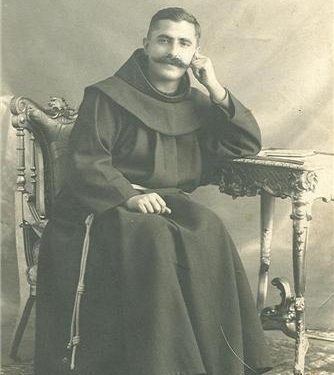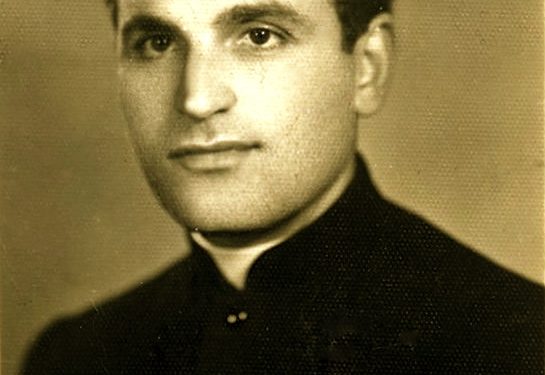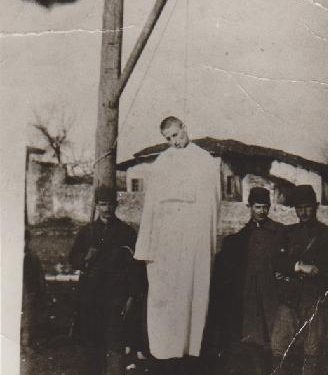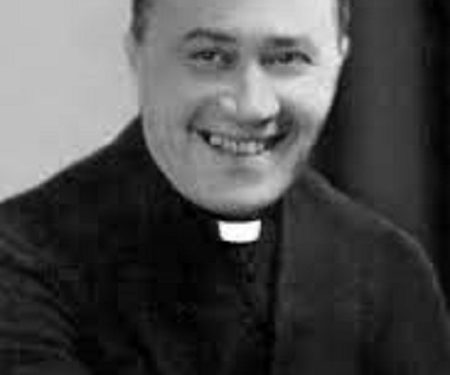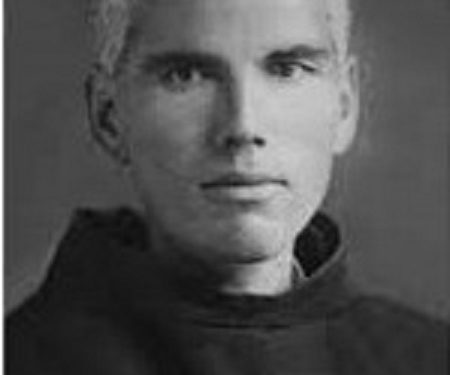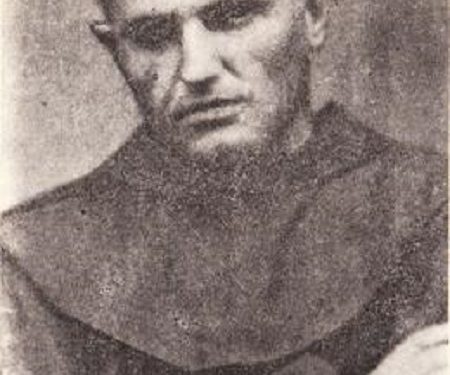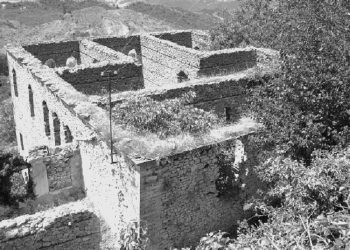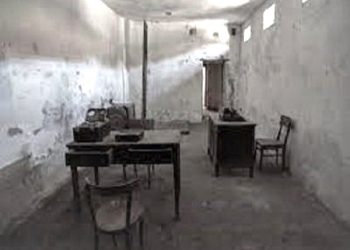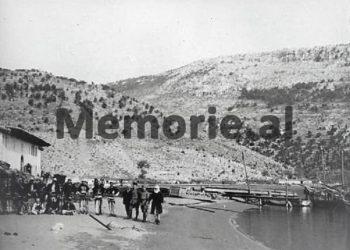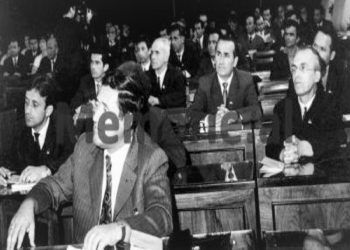By Dom Zef Simoni
The third part
Memorie.al publishes an unknown study by Dom Zef Simon, entitled “Persecution of the Catholic Church in Albania from 1944 to 1990”, where a Catholic cleric from the city of Shkodra who suffered for years in the prisons of the communist regime of Enver Hoxha and on April 25, 1993 he was ordained a Bishop by the head of the Holy See, Pope John Paul II, after describing a brief history of the Catholic Clergy in Albania, he stopped long at the persecution suffered by the Catholic Church in the regime communist, from 1944 to 1990. The complete study of Dom Zef Simon, starting from the attempts of the communist government of Tirana immediately after the end of the War to separate the Catholic Church from the Vatican, initially forbidding the Apostolic Delegate to return to Albania, Imzot Leone GB Nigris, after his visit to the Pope at the Vatican in 1945 and then with the pressure and threats against Monsignor Frano Gjini, Gaspër Thaçi and Vincens Prenushti, who strongly opposed the “offer” of Enver Hoxha and as a result were shot by as well as the tragic fate of many other clerics who were arrested, tortured and sentenced to prison, such as: Dom Ndoc Nikaj, Dom Mikel Koliqi, Father Mark Harapi, Father Agustin Ashiku, Father Marjan Prela, Father Rrok Gurashi, Dom Jak Zekaj, Dom Nikollë Lasku, Dom Rrok Frisku, Dom Ndue Soku, Dom Vlash Muçaj, Dom Pal Gjini, Fra Zef Pllumi, Dom Zef Shtufi, Dom Prenkë Qefalija, Dom Nikoll Shelqeti, Dom Ndré Lufi, Dom Mark Bicaj, Dom Ndoc Sahatçija, Dom Ejëll Deda, Father Karlo Serreqi, Dom Tomë Laca, Dom Loro Nodaj, Dom Pashko Muzhani, etc.
Continued from the previous issue
Study of Dom Zef Simon
Some secret services were set up in the city, and it was the case when a clerk teacher called the priest he knew in the late evening to find the sick man he had at home, and on that occasion, they also confessed and sang.
It was whispered that within a few years the churches of all religious institutions of all faiths would be closed. Hateful writings appeared in newspapers and books, fanatics, so distorted, with insults, insults, without anyone being able to give an answer, that there was no freedom of speech or press. Liri only had to speak and write badly. Monsignor Ernest Çoba’s meetings with the Prime Minister were less frequent. He presented to the minister these concerns that the Church had, but he remained silent. Approvals for the ordination of new priests did not come in this third stage.
In 1965, the Monsignor summoned the Prime Minister and announced the order to cut the number of bells to be reduced. Only a bell could ring on sunny days and festivals ordered in the town and village. Not in the morning, nor at lunch, nor in the evening. The beautiful bells of the city of Shkodra could no longer be heard.
The tactical looting of churches began. Near the church of the Jesuits and that of the Stigmatine sisters in Shkodra, were the respective assemblies, but they were taken by the state in 1946, to be used as dormitories for the youth. Now they have to take the churches as well. In the mid-nanduer half of 1965, Mons. Çoba is called early in the morning, at 8 o’clock in the morning, to the Council of the Front Organization of Shkodra district, whose chairman was Xhemal Dini.
All members of the Council were present, some of them. The Monsignor was informed that the two churches of Shkodra, that of the Jesuits and that of the nuns, would be handed over, since ‘they are near our dormitories, and the youth had nothing to do with the churches’. At first, they forcibly took the assemblies, now they definitely beg the Churches as well. The city was getting dark and the people were very worried that they were accustomed to increase their stature, mind and heart with the religious life near the churches and the Catholic youth, boys and girls to have their own.
He was now living in violence and oppression. Mons. Choba went to the Prime Minister to find out about these crazy churches. The clerk’s response was: “Now we can not interfere with the districts in their affairs.” The Jesuit church, after being taken over by the state, was used as a puppet showroom, and that of the Stigmatine sisters was renamed the “Youth Club,” which would later be used as a meeting room and a courtroom against priests.
On April 26, 1966, the day of Our Lady of Good Counsel, which was celebrated in Shejtnoren, the horn of Rozafat Castle, the day of the feast, a military unit categorically did not allow the Bishop, who had gone to the Church, to celebrate the Feast Mass, at 10, in front of a large people. The external pretext was that the army would open a tunnel for the church horn, and the internal reason was that the important religious and national Satanic Church in Albania would be closed for a few days.
On the night of Rëshaj this year, the Monsignor was summoned to the Executive Committee of the district of Shkodra. The Chairman of the Committee, Bilal Parruca, informed the Monsignor that the consecrations should take place in the church and not secretly in the Archdiocese Palace, as the Monsignor had indeed assigned to do for some people who had asked out of fear. “There is no need,” said the mayor. “Trust is free.”
The goal was for the state to know who would participate in the cremation. True, for this work, various groups were organized to control the cremation. On the day of Rëshaj, certain groups hold the children in their arms to dress well. But the children ran away from the perpetrators. It was communist deception with bad oriental forms. Communism has the power and power over, in general, Muslims.
The events came and went one after the other. A church was closed in Shala, and once his brother, Father Shtjefen Pistulli, left. On the day of St. Kolli, on the 6th, some young people and people in power left the Jesuit, Father Anton Luli, with a bang. They said to Padre: “We do not want a church, take your personal belongings and leave here. We want the church to be a house of culture. This is in the hands of the people and the youth.” The first signs of new events were clearly visible.
On Christmas night, in Shkodra, the Great Church was full of people, as always, but it was announced that in the city and villages in the late hours of this night, voluntary work with concentrated blows will be done. They started in Koplik to open canals under the sounds of the gang of the city of Shkodra.
In 1966, Lin Biao in Beijing sparked a very new movement, with the character of harshness and violence against any culture, except the proletarian one, which would be called the “Cultural Revolution”. Even in Albania, the year 1967 would be the year of these great events, the whole of Albania was confused. The “Cultural Revolution” started among us.
On February 6, 1967, at a meeting of several Party organizations in Tirana, Enver Hoxha gave the great signal of this revolution, of a furious war “against the backward customs and religious prejudices”, which would extend to all ends of the world. our homeland with the same intensity and fury. The Chinese cultural revolution became ours as well, with a civil war with concentrated blows, against all religions in Albania and especially against the Church and the Catholic Clergy.
When in 1945 Mehmet Shehu paid a visit to the house of the Jesuits in Tirana, during that meeting he said: “We are against the reactionary clergy and we exterminate our enemies, but, although we are atheists, we respect the good clergy and the freedom of religion and feelings of the believers “. Father Pjetër Meshkalla, who heard these words there, replied: “If you will be in power (an expression that is very bold and dangerous to question the existence of popular power), it will be time to destroy the church and the mosque, and you will persecute the feelings of the believers. ”
This period with the beginning of the cultural revolution in Albania, would have as its characteristic, not only the continuation of the persecution of the clergy in a new form, in that of the unmasking of the clergy, publicly, with meetings, so-called popular things, but mainly violence against the feelings of the believers, who dominated in Albania.
This spark that ignited “against the backward habits and religious prejudices”, was enough to ignite a big flame on the day of February 7, when the lightning bolts began to appear, resembling the Chinese dacibaove, and this burning flame of creeping for many years like an earthly hell of Albanian kjahmet. The city of Durrës saw groups of blind young people who destroyed the Orthodox Shrine of St. Vlash. A general headquarters was formed for the whole of Albania, under the leadership of Ramiz Alia, who was located in Shkodra in those days.
On February 15, 1967, at 10 o’clock, in all the doors of churches and mosques and in the places of posting, Chinese inventions were seen in the city “Lightning-leaf”, by groups of some young men and women, mostly young dormitories. What was not said in their honor: “Religion has played a reactionary role”, “the Vatican is the center of obscurantism”, “Clergy, the people call on you to hand over the churches, the cells and whatever you have”, “You have lied enough”, “Embrace work and earn bread with the sweat of your brow.” “You have cheated enough”, “People do not love you”. “Youth do not love you”
Neighborhoods, villages, every village and highland, cities, the capital everywhere rage that had the poison of the class. The clergy came from villages and highlands. Announce to the bishop. The Monsignor requested a meeting with the Prime Minister. Phones did not answer. Asked several times during those days. But they did not answer.
On the following Sunday, February 19, the 10 o’clock mass was not allowed to be celebrated. The Cathedral Church was closed by order. In the Shkodra Water Company, a large meeting is provoked, where Mons is called. Ernest Çoba, assistant parishioners Dom Mark Hasi and Dom Kole Shkoza. The Monsignor spoke properly and clearly belonged to the Lord of the Church. In the afternoon, the Great Church opens, after no decision was made by the people, and a large crowd filled the church in Mass.
The days are very busy, the Monsignor is called to the City Committee. They announced it together with the provincial of the Franciscans, Father Agustin Ashiku, and they called him to the Committee, to vacate the Franciscan rooms within a day and to send their materials to the Assembly of the Franciscans, to
Arra e Madhe, leaving only two rooms. In the meantime, a 15-member commission from the Executive Committee had arrived at the Archdiocese Palace.
Among them were Security officers, who took the keys to the palace and all the rooms, announcing that the people living in the archbishop would come to get their personal belongings and the other belongings of the archbishopric would be sent to the Assembly of Arra e Madhe . He continued to carry the state trucks for two days, because only he had them. This happened from the date of February 24 to the 26th.
Meetings continued to be very bitter in every neighborhood. There are screams of fear. The screaming crafts of some in the meetings were felt. “The church, the clergy have exploited the people. Religion has left it behind and in the dark. We want the closure of religious institutions.”
On the first Saturday of March, March 4, 1967, the Cathedral Church of Shkodra closes. The Church of the Frets of Gjuhadol and that of Our Lady of the Rosary at Arra e Madhe still remain. A large number of people then stayed in these two churches and followed them from the villages to receive the Holy Sacraments, and among them many, many young people. On March 15,16,17, special prayers were said by the clergy, and the Eucharist was exhibited in the closed-door Church of Our Lady of the Rosary.
On Saturday, March 18, in the office of the Front Council of Arra e Madhe, in front of a Front commission, with elements of both the party and the Security, about 20 priests were called one by one during the morning. They asked each of the priests to reject the denial of their priestly office. None agreed. And someone who had served the Front of Power, said: “Here we are not with you.” In the afternoon, all the frets who lived in the assembly were expelled, including the old Franciscan, Father Cyril Can, who did not know what it looked like.
Monsignor Ernest Çoba was taken by taxi to his sister and nephews’ house. A large crowd followed him with tears in their eyes and were very shocked by these events. On March 19, Sunday, the Day of St. Joseph and the Palm (Palm), there is no ringing sound and no church gates can be found in the city.
The closing of the Church in Lezha would be carried out with a devilish organization, on March 26, the day of Easter. The district party committee, which had a party secretary, state security, a large police force, front organizations, youth, school students, many people under duress, in the courtyard of the Church of the Franciscan Assembly proclaimed the “Assembly of three generations of Lezha” , read a decision in the name of the people, in 15 points, by which they demanded the closure of all churches and the complete firing of the Catholic faith with priests and believers. The crazy actions started that day, with the fall of the bell tower of the ancient Franciscan church.
Other days the bell towers and churches are flattened everywhere in Albania, such as the Shrine of Our Lady of Good Counsel, the horn of the Rozafat castle, the Cathedral Church of Shkodra, which for a few months was designated as a museum, but soon began to transform it, in 1968, into sports palace. The Franciscan Church of Gjuhadol became a cinema hall, the Shrine of Shnandout in Laç of Kurbin was destroyed and the whole area became a military camp, not to allow the people to go to the holy place for devotion.
The small church of artistic value in Laç of Vau i Dejës, a work of the XIII century, a church with frescoes and was declared a cultural monument, where every time our national hero, Gjergj Kastrioti, had gone to pray, he was completely destroyed dynamite. Many other churches were converted into culture halls, courtrooms, warehouses, and cattle and pig stables. It is true that some churches were not destroyed, but even worse than them, they were raped.
The church of the village of Sheldi with the priest, Dom Pjeter Gruda, had not been closed, a few days after Easter, the Church of the village of Delbinisht, with the parish priest Dom Anton Doçi, died in prison. This Church was closed last, on the day of Pentecost in 1968, because the people had taken the keys of the church and did not hand them over to the front and youth organization. And when they wanted to forcefully open the door of the church, the people, mostly women, came out with shovels and axes to stop them. The Church of the “Heart of Christ” in Tirana, with Monsignor Ndoc Sahatçi, was closed on June 29, 1967.
You, O Homeland, killed them at once, rest in peace. Only in a day of ‘Te Deum’ and in a Hallelujah of Handel can you be resurrected.
The priests were forced to take part in hard work, such as the brick company, the farm and the construction, but for a short time, because most were arrested for the second or third time, he was sent to heavy prisons, such as Spaç., where they would work among the copper and pyrite mines. Almost all the priests would disappear, so that they would not be seen by the people and by the people, because an imprisoned priest was for the communists a big open church.
With a contingent that Albania had on the eve of the entry of communism, over 170 priests, who, almost all, went through torture and tried life in prisons, with 31 priests shot, two of whom bishops, and two died in prison. 8 clergymen died under torture, drowned without trial. Died shortly after torture and imprisonment 2. Death in prisons and extermination camps 19 others. To be imprisoned, over 70.
On Good Friday, March 24, 1967, two days before Easter, so painful for us, for the Christian people, in the Catholic neighborhoods, groups of children from the pioneer organization entered the house to check the state of cleanliness, as spring time, but the main purpose was to refer to the information centers through the children where they had found among the families that they were making sweets and dyeing red eggs and not being seen in rosary rooms, crosses, figurines.
This so low and ugly event, which sought to degenerate the children, breaks the souls of the children with the very bad habit of denunciation and espionage. From time to time, especially in the villages, control was exercised until the coffers of women were hidden and other religious figures and materials. Certain people were monitored near different houses to listen, when the Rosary of the Virgin was said in the evening among the families, or not to listen to the foreign radio station, especially that of the Vatican Radio, in the Albanian language. /Memorie.al
Continues in the next issue





